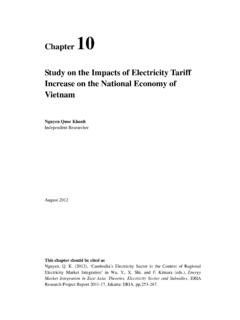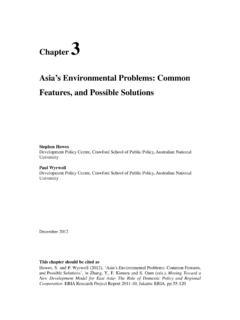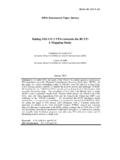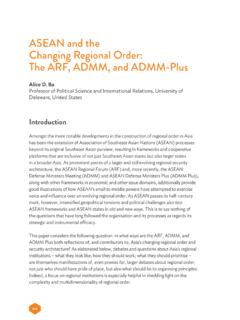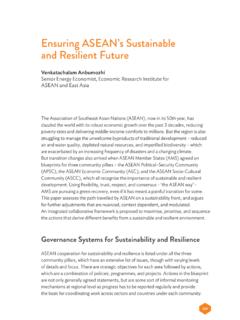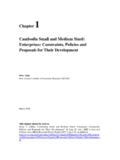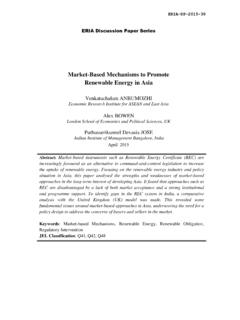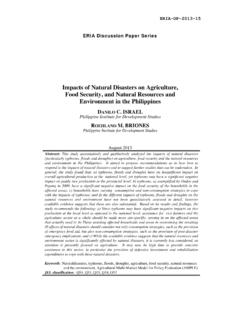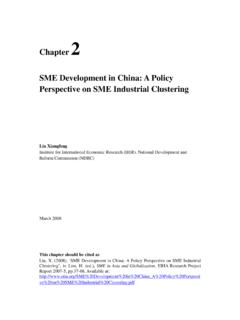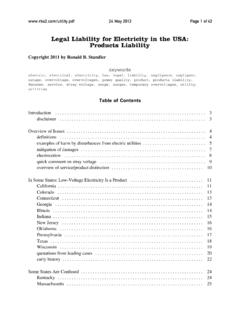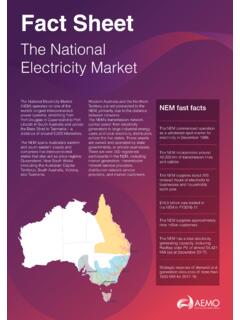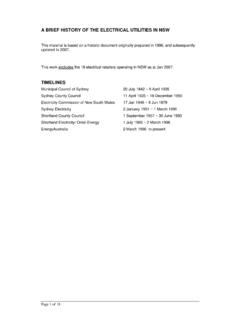Transcription of Chapter 7 Cambodia’s Electricity Sector in the Context of ...
1 Chapter 7. Cambodia's Electricity Sector in the Context of regional Electricity market integration Kongchheng Poch Economic Institute of Cambodia, Caombodia Savong Tuy JICA-PILAC2, Cambodia August 2012. This Chapter should be cited as Poch, K. and S. Tuy (2012), Cambodia's Electricity Sector in the Context of regional Electricity market integration ' in Wu, Y., X. Shi, and F. Kimura (eds.), Energy market integration in East Asia: Theories, Electricity Sector and Subsidies, ERIA Research Project Report 2011-17, Jakarta: ERIA, Chapter 7. Cambodia's Electricity Sector in the Context of regional Electricity market integration KONGCHHENG POCH. Economic Institute of Cambodia SAVONG TUY. JICA-PILAC 2, Cambodia Office Cambodia's integration into the regional Electricity market is a policy priority.
2 With a constrained supply-side, the increasing demand posts a critical challenge for Electricity Sector development. Against this backdrop, this paper provides an overview of the current situation of Cambodia's Electricity Sector and explores other critical issues in the Sector . Diesel and heavy fuel oil is the major source of power generation as hydropower will be the successor source in the future. Tariffs range from US 9-25/kWh for EDC grid and US 40-80/kWh for rural areas. Electrification rate through grid expansion is about per cent in 2009. Cambodia's Electricity tariff remains one of the highest in the region and the world. With a consolidate license, EDC, the state-owned utility, is the dominant key player in the Electricity market . Two main institutions playing important roles in governing the Electricity Sector include MIME and EAC.
3 The Electricity Sector remains underinvested. Only large scale investment projects are preferred in the market . High-voltage transmission connections, large-scale hydropower dams, and coal-fired plants have been the focused priority for power development thus far. Barriers to investments include huge capital requirement for large-scale projects, insufficient legal and institutional framework, and high administrative costs. Therefore, it is essential that national grid development is accelerated and more investment is encouraged in order to reduce current high tariffs. Investment climate must be enhanced to be conducive to foreign and local investment. 141 1. Introduction Energy cooperation is one of the focused priorities in the East Asia Summit (EAS). region.
4 To advance this cooperation, energy market integration is, among other things, laid out by the member countries to address barriers of trade and investments in the energy Sector across the region. Being a member of the sixteen-countries-EAS region, Cambodia, one of the poorest countries in the region, needs to take steps to accelerate this envisaged integration and to fulfill its increasing demand for Electricity for continued economic development. Cambodia has achieved strikingly high rates of economic growth over the past ten years; the real gross domestic product (GDP) grew on average % per annum. This robust growth has stimulated substantially-increasing demands for Electricity . With a constrained supply-side, Cambodia faces critical challenges in satisfying this greater demand.
5 In this regard, regional Electricity market integration serves as a useful tool for Cambodia to optimize benefits enhancing the domestic Electricity Sector and to further regional energy cooperation. Despite remarkable improvement in the energy Sector , the electrification rate in Cambodia remains low. The majority of the population is not connected to electric power networks. Moreover, Electricity cost remains one of the highest in the region and the world. Investment in the Electricity Sector represents a small proportion of the total investment needed for Electricity Sector development. Although Electricity imports from neighboring countries have been on the rise, the supply of Electricity still suffers shortage and reliability. Electricity market players are diverse, ranging from small Rural Electricity Enterprises (REEs) and Independent Power Producers (IPPs) to the state-owned utilities while a national power grid has not yet materialized.
6 In terms of regional cooperation, the government's current policies and strategies have significant effects and implications for Electricity supply and coverage in Cambodia. Against this background Cambodia's Electricity Sector has steadily developed in the past decade, although its development has not been at parity with the pace of economic development. Therefore, to better understand the current situation of the Cambodia's 142 Electricity Sector , this paper considers the overall situation and progress of the Sector in the Context of regional integration . It is crucially important to shed light on furthering development of the Electricity Sector in Cambodia and integrating Cambodia's Electricity market into the region. With the main purpose of providing a general background of the Electricity Sector in Cambodia, the study has five objectives as follows: 1) To lay out an overview of Cambodia's Electricity Sector covering issues such as supply, demand, transmission, tariffs, investment, access, electrification, and government strategies and policies.
7 2) To summarize present strategies and policies of the Cambodian government in regards to the ASEAN Power Grid (APG);. 3) To understand the current situation of investment in the Electricity Sector covering issues such as key market players, main investment barriers, and the attraction of foreign investment in the Sector ;. 4) To illustrate a case study of Cambodian Electricity imports from Vietnam; and 5) To explore other issues which are significant and relevant to Electricity Sector . 2. Overview of the Cambodian Economy Cambodia, officially known as the Kingdom of Cambodia, is a member of the Association of the Southeast Asian Nations (ASEAN) and Greater Mekong Subregion (GMS). Situated at the heart of the GMS, Cambodia is a land of rice and forest covered by the Mekong River and Tonle Sap Lake (ESMAP, 2005).
8 It is bordered with Thailand and the gulf of Thailand in the West and South respectively, Vietnam in the East, and Lao PDR in the North. With a total area of 181,035 Km2, Cambodia has a total population of about 15 million, of which approximately 80 % live in rural areas. Cambodia had gone through several civil wars over three decades since the military coup d' tat in 1970. In particular, the Cambodian economy had been gravely destroyed during the genocidal Democratic Kampuchea regime during 1975-1979. As a result, the economy plunged into almost zero levels of growth because either physical or non- 143 physical infrastructure had been demolished. The economy began to develop from this level as a socialist economy before it embarked upon free- market economy in 1989.
9 (MoE, 2002). The country had its first national election in 1993, and the economy developed gradually and steadily to be a post-conflict economy in 1999 when reconciliation among all political tendencies was successfully accomplished. In the last decade, Cambodia enjoyed exceptionally high rates of economic growth. The economy grew per annum on average during 2001-2010. 1 The economy experienced the highest growth rate at percent in 2005. Later, it declined from in 2008 to in 2009 due to global economic downturn in 2008/2009 because Cambodia's major economic sectors such as garment, tourism, and construction dramatically contracted. Real GDP growth started to edge up again to around in 2010 and was estimated to realize a rate of in 2011 (Khin, et al. 2012).
10 In the meantime, Cambodia needs to achieve at least an average growth rate of 6-7% per annum to achieve sustainable poverty alleviation in accordance with government policy ambitions. In this regard, development of the electric power Sector needs to be hastened to support sustainable growth and economic development. Figure 1: Cambodia's Real GDP Growth Rate over 2001-2011. 2001 2002 2003 2004 2005 2006 2007 2008 2009 2010 2011. Source: Data compiled from NIS and EIC estimate (2011). 1. Data compiled from the National Institute of Statistics (NIS). 144 3. Electricity in the Energy Sector Overall Situation The power Sector in Cambodia is supplied by different sources such as heavy fuel oil (HFO), diesel, gasoline, gas, wood, coal, hydropower, wind and solar energy, biomass, and biogas (World Bank, 2006).
